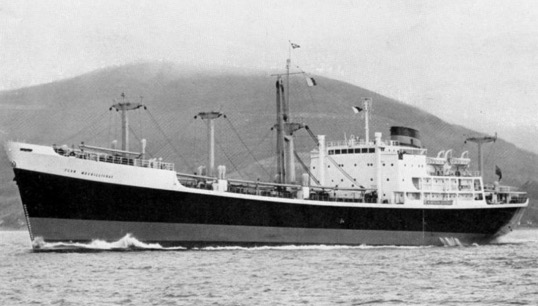Clan Macgillivray

The build
The Clan Macgillivray was the 16th Clan Line vessel to have been built by the Greenock Dockyard Company. The 8,811grt was powered by a six-cylinder Barclay Curle Sulker-type turbocharged Diesel engine, developing 8,500bhp at 118rpm. Clan Macgillivray had a service speed of 16.5 knots and was equipped with three Rolls-Royce diesel generators, which earned a reputation for being very noisy.
The ship featured an air-conditioned and partially sound-insulated engine control room from which an officer could monitor systems, manoeuvre the main engine, start and stop pumps and control and parallel the diesel generators.
Automatic controls and alarms were provided for temperature, pressure and other systems. Remote and automatic controls meant that on an ordinary seagoing watch only one engineer officer and one greaser were required.
The bridge design was uncluttered, with instruments in the wheelhouse grouped and fitted in consoles in suitable ergonomic positions. Equipment included a Decca navigator, and hand and automatic steering gear controlled electrically from the bridge by an Arkas autopilot linked to a Sperry gyro compass.
Douglas Tennant, general secretary of the Nautilus predecessor union Merchant Navy & Airline Officers' Association (MNAOA) noted that the Clan Macgillivray was one of the first in the UK fleet to feature extensive levels of engineroom automation, and he expressed concerns on the impact of automation upon seafarers.
'What we are face with now is the speed-up of a hitherto slow trend to automation,' Mr Tennant said. 'While MNAOA does not intend to attempt anything to futile as to stand in the way off the march of progress, it certainly intends to everything to ensure that seafarers are not penalised by new developments and that they get their fair share of any benefits flowing from them.'
Clan Line responded to these concerns by stating that the high level of automation was intended to minimise operating costs and maximise the efficiency of the carriage and handling of cargo.
'We are undergoing the stiffest international competition in our history,' warned company chairman Lord Rotherwick. 'We have got to remain competitive and therefore we have to have new, up-to-date economic equipment.'
When trials were completed in August 1962, Clan Line proudly boasted the vessel would operate with a 20% saving on engineroom crewing costs. In reality, the company had been following the footsteps of Japanese owners, who had pioneered the use of remote-control engineering systems in 1960.
Clan Macgillivray Fact File
How big was the Clan Macgillivray?
The Clan Macgillivray had a grt of 8,811.
Where was the Clan Macgillivray built?
The Clan Macgillivray was built at the Greenock Dockyard in Scotland.
Where did the Clan Macgillivray make its maiden voyage to?
The Clan Macgillivray made its first voyage from Liverpool to India.
When did the Clan Macgillivray end its service?
The Clan Macgillivray ended its service in October 1984 after operating as the Hong Kong-flagged Clan Macboyd.
Deployments
The Clan Macgillivray made its first maiden voyage from Liverpool to India with a British master, 13 officers and four cadets, and 44 Asian ratings.
Originally laid down for King Line as King Edward, Clan Macgillivray traded extensively between the UK, South and East Africa, the Middle East, the Indian sub-continent and Australia, and was switched to the King Line fleet in 1969 before returning to Clan Line in 1977.
By this time parent company British & Commonwealth was rapidly diversifying and running down its shipping interests. Clan Macgillivray was one of the last Clan Line ships in service, but was sold in 1981 and operated as the Hong-Kong flagged Clan Macboyd before scrapping in Shanghai in October 1984.
Contribute
Are you knowledgeable about this vessel?
Submit your contribution to this article to our editorial team.
Write to usView more ships of the past
HMS Beagle
Launched 200 years ago, HMS Beagle has been described as one of the most important ships in history – thanks to the observations on evolution and natural selection that its famous passenger Charles Darwin made during a five-year voyage around the world between 1831 and 1836.
Common.ReadMoreHMS Beagle
Manchester Challenge
Launched in June 1968, Manchester Challenge was one of the first British-built and operated cellular containerships, and it entered service in November that same year.
Common.ReadMoreManchester Challenge
Esso Ulidia
Delivered in October 1970, Esso Ulidia was one of eight 250,000dw-plus ships, which were all named after old British and Irish kingdoms, to be constructed for Esso's red ensign fleet between 1969 and 1973.
Common.ReadMore